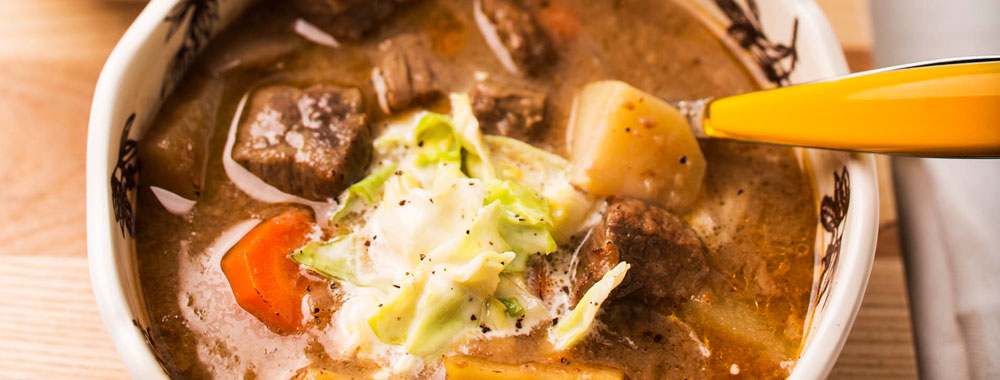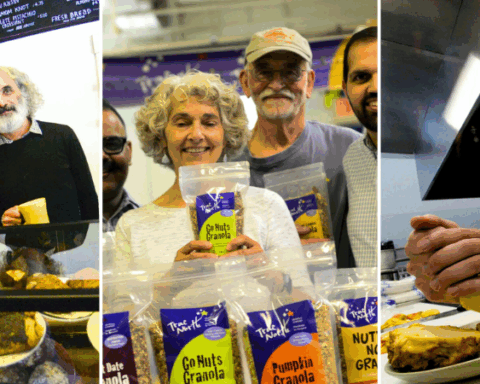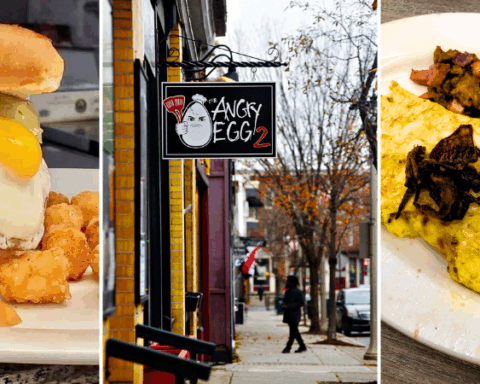For Maggie Stuckey, gatherings around soup nights bring comfort to the season.
By Jennifer Huberdeau
Winter brings many things in New England: shorter days, longer nights, layered clothing, blustery winds, sub-zero temperatures, snow and ice.
Hearty New Englanders take the cold weather in stride, turning the long, frigid nights into opportunities to enjoy a bowl of winter soup.
Stews brimming with beef, pots filled with lentils, creamy chowders and bowls of perfectly blended winter squashes can warm the body and nourish the soul when shared with family, friends and neighbors.
According to Maggie Stuckey, author of “Soup Night: Recipes for Creating Community Around a Pot of Soup,” the only thing better than a hot bowl of soup on a cold day is a community gathering around a pot of hot soup.
“At its core, Soup Night is a stunningly simple idea: Get everybody together once a month for an informal soup supper,” Stuckey wrote in her book, which was first published in 2013 by Storey Communications.
“What is not so simple — what is in fact extraordinary — is what happens next. A strong sense of community replaces social isolation. People no longer feel like strangers. Children thrive in a safe environment, watched over by many loving adults … Life seems richer, kinder, sweeter, and more fun. And that is healthier, in all dimensions: Physical, psychological and emotional.”
Unlike similar cookbooks, “Soup Night” is filled with more than just soup recipes. It’s a cookbook with a recipe for planning a soup-themed event to invite your neighbors and co-workers. It’s a blueprint crafted from several years of research and collecting the perfect soups and stories to include within its pages. In all, the 304-page book includes 99 soup recipes, 40 recipes for salads, breads and desserts, as well as the basic starting blocks for a successful soup night of your own.
Not sure if a soup night is for you? In the following Q&A, author Maggie Stuckey makes the case for hosting a soup night and shares a few insights about her favorite recipes.
Q. Why host a soup night? What makes a soup night different than a traditional potluck?
A. Sharing a meal with your neighbors, getting to know them, is a wonderful thing, no matter what’s on the menu. But soup adds something special.
Soup is the ultimate comfort food; it’s warm, familiar, unpretentious and soothing. At our soup nights, I have seen people arrive who are clearly still dealing with the stress of the day. Then they sit down with their bowl of soup, hold it in both hands to absorb its warmth, lean in to enjoy the fragrance, and they smile, whisper “ahhh,” and visibly relax. You can just see the stress fall away. That’s the magic of soup.
Q. What’s your favorite winter soup to share?
A. Well, that’s a little like asking a parent to pick a favorite child. But if I have to choose just one, I would go with Taco Soup. For several reasons: It’s amazingly flexible. You can leave out some ingredients if you need to ( I don’t like celery, so I just leave it out; no harm done), substitute one thing for something else, and it’s still wonderful.
It’s also a good way to accommodate various dietary considerations. You can make a basic version that’s completely vegetarian and vegan, and serve things like meat and cheese on the side. And one big reason: Kids always like it. And soup nights really should have a herd of adorable children racing around.
Q. What’s your favorite soup that has been shared with you?
A. One feature of my book that delights me is that so many of the Soup Night groups from all over the country graciously shared their recipes with me. One that seems especially appropriate as we head into cold weather is Carrot-Orange-Ginger Soup from a soup night in Loveland, Colorado.
Flavored with ginger, nutmeg, and maple syrup, it’s a little bit unusual, a little bit exotic, but absolutely delicious. It’s also extremely healthy, rich in powerhouse nutrients that help ward off the sniffles. It’s the best kind of medicine.

Excerpted from “Soup Night”, © by Maggie Stuckey.
Surprise Beef Stew
I’ve been making beef stew for a long time, and I always thought mine wasn’t half bad — until I tasted the version made by my Ocean Park, Washington, neighbor, Kennette Osborn. Her part-German grandmother taught her to make the stew, and it is really good. It helps that she has access to local beef, raised organically, and the allspice lends a touch of mystery. But what really makes it extraordinary is the surprise — coleslaw. That idea came from her late husband, which makes this a true family recipe. Take a big spoonful, she said, and stir it into your bowl of hot stew. I admit, at first I was skeptical. But trust me, and give it a try. The raw cabbage adds a nice crunch, and the dressing makes the whole thing creamy, but in a nice way. I’d change only one thing: add mushrooms. And I agree with Kennette’s suggestion to use a cast-iron frying pan.
Serves 4–6.
Ingredients:
1 cup all-purpose flour, approximately
Seasoned salt
1½ pounds beef stew meat, cut into 1-inch cubes
¼ cup olive oil (more if needed)
1 medium onion, chopped
3 garlic cloves, minced
1–2 cups beef broth
1 tablespoon sugar
½ teaspoon ground allspice
½ teaspoon paprika
3 bay leaves
Salt and freshly ground black pepper
1–2 carrots, cut into bite-size chunks
3 thin-skinned potatoes (such as red, Yukon Gold, or Yellow Finn)
Directions
1. Make the stew: Mix the flour and seasoned salt, and dredge the meat until each piece is well coated (a plastic bag makes this easy). Add the oil to a large soup pot, deep skillet, or Dutch oven and brown the meat over medium-high heat. Work in batches if needed to make sure each piece is well browned.
2. To the same pot, add the onion and garlic (add a little more oil at this point, if needed), and sauté until the onion is soft. Add enough beef broth to cover the meat, along with the sugar, allspice, paprika, bay leaves, and salt and pepper to taste. Cover the pot, and reduce the heat. Simmer until the meat is tender, about 40 to 50 minutes (longer doesn’t hurt).
3. Add the carrots and potatoes and cook until the vegetables are tender, 10 to 15 minutes. If the liquid seems thin, mix a little cornstarch with cold water and add it a little at a time.
4. Make the coleslaw: Shred the cabbage (or start with a bag of coleslaw mix from the supermarket, already shredded).
5. Whisk the mayonnaise, sugar, and mustard together, and gradually add the cream until you get the consistency you like. Pour the dressing over the cabbage, mix well, and add salt and pepper; taste and adjust seasonings. Ideally, it’s best to let this “brew” for an hour or two before serving.
6. Serve the stew in shallow bowls, and pass the coleslaw so that each person can take a large spoonful to stir into the stew.
Bouquet Garni
Any dish that cooks slowly for a long time in the oven or on the stove — like beef stew — is a good candidate for a bouquet garni. It sounds fancy, but it’s just a small bundle of various herbs and spices, tied together in some way and submerged in the liquid. The bundle can be created simply by tying sprigs of herbs together with twine , or by folding them into a tied packet of cheesecloth. Or use one of those screw-together metal balls meant for tea; they come in large sizes (for brewing a whole pitcher), and that’s the most versatile. The whole idea is that the essence of the herbs seeps into the dish, but the herbs themselves — now soggy and with most of the flavor extracted — are easy to remove at the end.
Excerpted from “Soup Night”, © by Maggie Stuckey.
Vegetable Soup with Andouille Sausage
Andouille sausage is a smoked, highly seasoned pork and beef sausage that is especially popular in the South. It adds a great spicy flavor to this soup. And here is another opportunity to use up some of your zucchini!
Serves 6.
Ingredients
3 1/2 cups water
2 cups reduced-sodium chicken broth
1 cup dried brown lentils, picked over and rinsed
1 medium onion, chopped
1 celery stalk, sliced
2 carrots, sliced
1 tablespoon chopped fresh parsley
1 teaspoon salt
1 medium zucchini, cut in half lengthwise, then sliced into 1/2-inch pieces
6 ounces andouille sausage, halved lengthwise and cut into 1/2-inch pieces
Lemon wedges, for garnish (optional)
Directions
1. In a large soup pot over high heat, bring the water, broth, lentils, onion, celery, carrots, parsley, and salt to a boil. Reduce the heat to medium-low and simmer, covered, for 45 minutes, stirring occasionally.
2. Add the zucchini and sausage and simmer, covered, until the vegetables are tender and flavors are blended, about 10 minutes longer.
3. Serve with a squeeze of lemon on top, if desired. Or set out bowls of lemon wedges so people can add their own. Or both.
Make ahead? Yes, up through end of step 1.
For large crowds: This soup lends itself well to being expanded. For economy, you might want to keep the amount of sausage proportionally lower, but its flavor will still come through.

Excerpted from “Soup Night,” © by Maggie Stuckey.
Butternut and Acorn Squash Soup
Recipe from Martha Bayne, Chicago Soup and Bread. Martha says: “This soup is adapted from one found in the Soup & Bread Cookbook. It was created for Soup & Bread by a Chicago filmmaker named Jack Newell, who in turn adapted it from a recipe in Eric Ripert and Michael Ruhlman’s A Return to Cooking. Such is the mutable — and community-built — nature of soup.”
Try adjusting the proportions of acorn to butternut squash — or swap in a cup of sweet kuri squash. Or roast an apple in the oven and then throw that in the mix as well. If you are really lazy, you can roast the squash in its skin first (see page 77) and then just scoop out the innards and add the squash to the sauté mix.
Serves 6-8.
Ingredients:
6 tablespoons unsalted butter
1 cup sliced yellow onion
2 cups peeled and diced acorn squash
2 cups peeled and diced butternut squash
Sea salt
Freshly ground white pepper (fresh and white are important)
5 cups chicken broth
1 cup heavy cream or half-and-half
3 sprigs fresh thyme
3 ounces sharp cheddar cheese, grated (¾ cup)
Optional seasonings: ground nutmeg, honey, cayenne, and/or minced fresh ginger
Directions
1. Melt 2 tablespoons of the butter in a large soup pot over medium heat. Add the onion and sauté until translucent, 3 to 5 minutes. Add the acorn and butternut squash and sauté until soft, maybe 10 minutes.
2. Season the squash mixture with salt and pepper, add the broth, and bring to a simmer. Cook until the squash is tender, about 30 minutes.
3. Transfer the soup to a blender and purée until smooth. For extra-satiny smoothness, pass the soup through a fine sieve after it’s puréed.
4. Return the soup to the pot, and add the cream and the remaining 4 tablespoons butter. Simmer.
5. Wrap the thyme in a piece of cheesecloth and tie with string to make a little bundle. Add it to the simmering soup and let it infuse for 10 minutes, then remove.
6. Add the cheese and mix gently until incorporated. Add optional seasonings as desired and serve hot.
Excerpted from “Soup Night”, © by Maggie Stuckey.
Sweet Corn Chowder
Recipe from Elizabeth Newland, Civano Soup Supper, Tucson, Arizona. Elizabeth says: “Always a potluck favorite . . . tasty and no strange ingredient surprises!”
Serves 4–6.
Ingredients:
5 bacon strips, diced
1 small leek, trimmed and thinly sliced
2 teaspoons fresh thyme or winter savory, or 1/2 teaspoon dried
Salt and freshly ground black pepper
2 large russet potatoes, peeled and cubed
2 cups milk
2 cups cream
2 cups corn kernels, fresh or frozen (preferably fresh)
Directions
1. Brown the bacon in a large soup pot over medium heat until crisp, 5 to 7 minutes. Drain off all but 2 tablespoons of the bacon fat.
2. Add the leek, thyme, and salt and pepper to taste to the pot and sauté until the leek is softened, about 5 minutes.
3. Stir in the potatoes, milk, and cream, and bring to a gentle simmer over medium heat. Simmer (do not boil) until the potatoes are tender.
4. Add the corn and continue to simmer until the corn is tender, about 4 minutes for fresh or 7 minutes for frozen.
5. Serve hot.
Variations: Elizabeth suggests, “This soup can be dressed up by adding mushrooms or shrimp.” When the corn is tender, stir 1/2 cup sautéed mushrooms or 1 cup cooked shrimp into the soup, bring up to heat, and serve.
Make ahead? Prepare through step 3, but remove from the heat just before the potatoes are completely cooked. Refrigerate. Rewarm at serving time, simmering until the potatoes are totally tender.
For large crowds: This recipe is easily doubled or tripled. To economize, use chopped parsley or chives as garnish in place of the shrimp.
Jennifer Huberdeau is New England Newspapers’ online editor and associate editor of UpCountry magazine. She also pens the column, “The Cottager,” for Berkshires Week and The Shires of Vermont.












